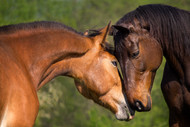Bot Fly Larvae & Horses
Posted by Darren Walton on 16th Jul 2021
For a full list of products go to our horse wormers page
Bots, the insect larvae of the bot fly, are common parasites found within the stomach of horses. Unfortunately, an infestation of bot fly larvae will not show up in a faecal worm egg count, so it is difficult to know whether or not your horse is affected.
Female bot fly are prolific egg layers, producing up to 1,000 eggs which are a distinctive yellow colour. Laid on your horses’ legs, around the eyes and mouth and on the shoulders, the horse will inadvertently ingest the eggs when grooming themselves or a companion. The larvae will then mature in the mouth and develop in the stomach for up to 12months before emerging in the horses’ dung. Following excretion the larvae will burrow into the ground, developing into adults. Adults emerge within 3-10 weeks depending upon conditions, at which point the cycle begins again.
Although the exact harm caused by bot fly larvae is not well understood, an annual control routine is considered the best way to prevent any potential harm.
By removing the eggs from the horse using a bot knife, or controlling the fly population using a fly repellent or insecticide would theoretically prevent infection; in practice it would be virtually impossible to prevent all eggs from being ingested.
In practice the best method for controlling bots is to administer a suitable horse wormer in the winter. This would need to be administered after the first frosts when the adult fly population has died off, preventing re-infection, and before the bots mature in the stomach.
Not only will treating the bot fly larvae in the winter help to ensure your horses continued health; by preventing the bot fly larvae from completing their life cycle, the local population of bot fly the following summer will be reduced. This will reduce the fly nuisance experienced by the horse and reduce the likelihood of re-infection in subsequent seasons.

